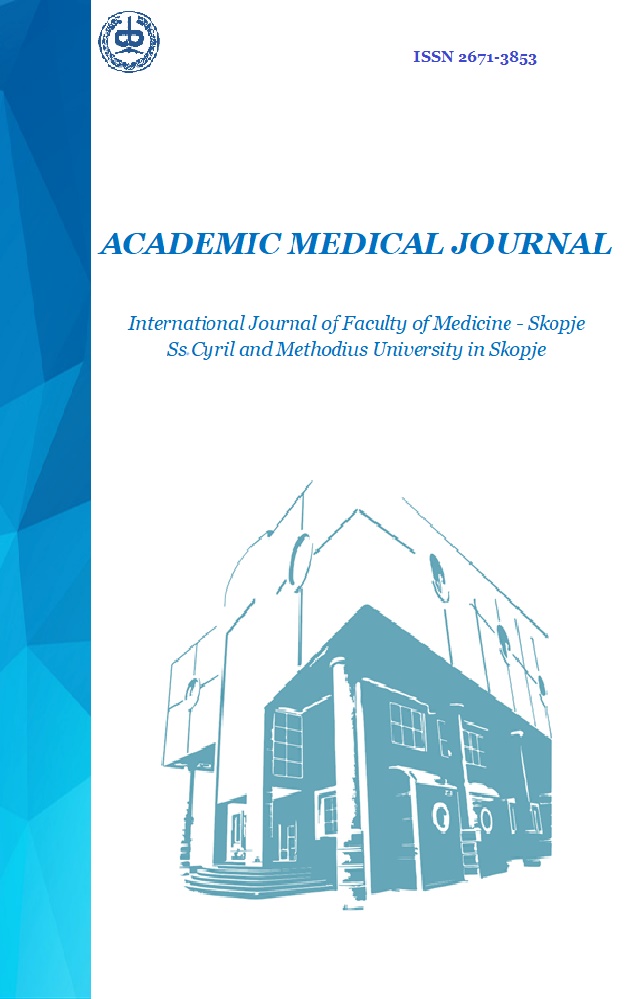THE IMPACT OF AGE AS RISK FACTOR IN THE DEVELOPMENT OF SYMPTOMS OF MUSCULOSKELETAL DISORDERS RELATED TO WORK OF A DEFINED GROUP OF NURSES
Keywords:
aging, musculoskeletal disosrders, nursesAbstract
Introduction: If musculoskeletal disorders are caused or aggravated by work and/or the effects of the immediate work environment, they are called work-related musculoskeletal disorders (MSD). The physical capabilities that enable people to cope with the physical demands of work are naturally subject to decline with age.
Aim: The aim of the paper was to assess the influence of age as a risk factor in the development of symptoms of musculoskeletal disorders related to work in a defined group of nurses.
Material and method: The study included 160 nurses divided into two groups. The first group consisted of nurses under 45 years of age, and the second group nurses over 45 years. The used instrument was the medical history questionnaire and checklist for work-related MSD symptoms from the Canadian Centre for Occupational Health and Safety
Results: Musculoskeletal pain was registered in a total of 136 (85%) nurses, of which 71 (100%) nurses were over 45 years of age, and 65 (73.0%) nurses under 45 years of age. 20.2% of nurses under 45 years of age and more than half (57.7%) of nurses over 45 years of age were absent from work due to musculoskeletal disease. 33.8% of nurses over 45 years of age were hospitalized due to musculoskeletal disorder.
Conclusion: The results of our study and literature data indicate a significant influence of age on the development of symptoms of work-related musculoskeletal disorders in nurses. Therefore, timely ergonomic intervention and regular health monitoring is necessary.
References
OSHA. Ergonomics: The Study of Work. U.S. Department of Labor Occupational Safety and Health Administration; 2000.
European agency for safety and health at work. Work-related musculoskeletal disorders: Back to work report. No 3. Luxembourg: Office for Official Publications of the European Communities; 2007.
WHO, International Classification of Diseases, ICD-11
(www.who.int/classifications/icd/en/)
WHO- Musculoskeletal conditions Fact sheet, February 2018
(http://www.who.int/mediacentre/factsheets/musculoskeletal/en/)
Jannatbi LIti, Nigudgi SR, Shrinivas R. Assessment of musculoskeletal disorders by standardized Nordic questionnaire among computer engineering students and teaching staff of Gulbarga city. Int J Community Med Public Health 2016; 3(3): 668-674. doi: https://doi.org/10.18203/2394-6040.ijcmph20160630
Palmer K, Goodson N. Ageing, musculoskeletal health and work. Best Pract Res Clin Rheumatol 2015; 29(3): 391–404. doi: 10.1016/j.berh.2015.03.004.
Voorbij AIM, Steenbekkers LPA. The composition of a graph on the decline of total body strength with age based on pushing, pulling, twisting and gripping force. Applied Ergonomics 2001; 32(3): 287-292, https://doi.org/10.1016/S0003-6870(00)00068-5.
Villa-Forte A. (2022). Effects of Aging on the Musculoskeletal System. MSD Manuel Consumer Version.
Canadian Centre for Occupational Health and Safety. Work-related musculoskeletal disorders. CCOHS; 2014. http://www.ccohs.ca/oshanswers/diseases/rmirsi.html
National Health Statistics Reports. Use of Complementary Health Approaches for Musculoskeletal Pain Disorders Among Adults: United States; 2012 http://www.cdc.gov/nchs/products/nhsr.htm
Carayon P, Xie A, Kianfar S. Human factors and ergonomics as a patient safety practice. BMJ Qual Saf 2014; 23: 196–205. https://doi.org/10.1136/bmjqs-2013-001812.
Yasobant S, Rajkumar P. Work-related musculoskeletal disorders among health care professionals: A cross-sectional assessment of risk factors in a tertiary hospital, India. Indian journal of occupational and environmental medicine 2014; 18(2): 75–81. https://doi.org/10.4103/0019-5278.146896
Percentage of workers reporting backache in the past 12 months, by sector (NACE rev 2), EU-28, 2015. European Working Conditions Survey (EWCS) (https://healthy-workplaces.eu/en)
Owen BD, Keene K, Olson S. An ergonomic approach to reducing back/shoulder stress in hospital nursing personnel: a five year follow up. Int J Nurs Stud 2002; 39(3): 295–302. doi: 10.1016/s0020-7489(01)00023-2.
Ellapen TJ, Narsigan S. Work related musculoskeletal disorders among nurses: Systematic review. J Ergon 2014; S4:3. https://doi.org/10.4172/2165-7556.S4-003.
Heiden B, Weigl M, Angerer P, Müller A. Association of age and physical job demands with musculoskeletal disorders in nurses. Appl Ergon. 2013;44(4):652-8. https://doi.org/10.1016/j. apergo.2013.01.001
PMid:23399023
Camerino D, Conway PM, Van der Heijden BI, Estryn-Behar M, Consonni D, Gould D, Hasselhorn HM; NEXT-Study Group. Low-perceived work ability, ageing and intention to leave nursing: a comparison among 10 European countries. J Adv Nurs 2006; 56(5): 542-52. doi: 10.1111/j.1365-2648.2006.04046.x.
Simon M, Tackenberg P, Nienhaus A, Estryn-Behar M, Conway PM, Hasselhorn HM. Back or neck-pain-related disability of nursing staff in hospitals, nursing homes and home care in seven countries—results from the European NEXT-Study. International Journal of Nursing Studies 2008; 45(1): 24-34. https://doi.org/10.1016/j.ijnurstu.2006.11.003.
(https://www.sciencedirect.com/science/article/pii/S0020748906003117)
Picavet HSJ, Schouten JSAG. Musculoskeletal pain in the Netherlands: prevalences, consequences and risk groups, the DMC3-study. Pain 2003; 102: 167–78. doi: 10.1016/s0304-3959(02)00372-x.
Leroux I, Dionne CE, Bourbonnais R, Brisson C. Prevalence of musculoskeletal pain and associated factors in the Quebec working population. Int Arch Occup Environ Health 2005; 78: 379–86. doi: 10.1007/s00420-004-0578-2.
Parsons S, Breen A, Foster NE, et al. Prevalence and comparative troublesomeness by age of musculoskeletal pain in different body locations. Fam Pract 2007; 24(4): 308–316. doi: 10.1093/fampra/cmm027.
Palmer KT, Griffin MJ, Syddall HE, Pannett B, Cooper C, Coggon D. The relative importance of whole body vibration and occupational lifting as risk factors for low-back pain. Occup Environ Med 2003; 60(10): 715-721. doi: 10.1136/oem.60.10.715.
Schultz CC, Colect CF, Treviso P, Stumm EMF. Factors related to musculoskeletal pain of nurses in the hospital setting: cross-sectional study. Rev Gaucha Enferm 2022; 43: e20210108. doi: 10.1590/1983-1447.2022.20210108.en.
Ou Y-K, Liu Yi, Chang Y-P, Lee B-O. Relationship between Musculoskeletal Disorders and Work Performance of Nursing Staff: A Comparison of Hospital Nursing Departments. International Journal of Environmental Research and Public Health 2021; 18(13): 7085. doi: 10.3390/ijerph18137085.
Ribeiro T, Serranheira F, Loureiro H. Work related musculoskeletal disorders in primary health care nurses. Applied Nursing Research 2017; 33: 72-77. https://doi.org/10.1016/j.apnr.2016.09.003.
Arsalani N, Fallahi-Khoshknab M, Josephson M, Lagerström M. Musculoskeletal disorders and working conditions among Iranian nursing personnel. Int J Occup Saf Ergon 2014; 20(4): 671-680. doi: 10.1080/10803548.2014.11077073.
Stanchev V, Vangelova K. Musculoskeletal Disorders in Nurses in Hospitals. Open Access Maced J Med Sci 2022; 10(E): 439-443. doi: https://doi.org/10.3889/oamjms.2022.8920.
Downloads
Published
Issue
Section
License
This work is licensed under CC BY 4.0 





